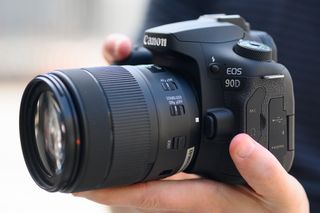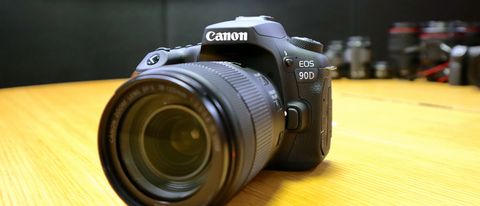Hands on: Canon EOS 90D review
Canon's first camera to boast 4K uncropped video
EARLY VERDICT
With the EOS 90D, Canon has proven that DSLRs aren’t quite ready to kick the bucket yet. A welcome bump in sensor resolution and burst speed – and the first Canon camera to boast 4K uncropped video – sets the EOS 90D apart from the mid-range crowd. For Canon fans unwilling to move to the mirrorless fray, this snapper is set to be a formidable all-round option.
FOR
- 32MP resolution
- Up to 11fps burst
- Uncropped 4K video
- Joystick control
- Deep grip
AGAINST
- No USB-C charging
There weren’t really any surprises left to unveil when Canon finally announced the EOS 90D earlier this week – pretty much everything had been revealed in leaks in the days leading up to the launch. Yet, when we got our hands on the new snapper, we still couldn’t contain our excitement.
Canon’s next mainstream DSLR takes the best of what the excellent EOS 80Dhad to offer, adds a touch from the EOS 7D Mark II, then improves upon that amalgamation both under the hood and physically. With a new 32.5MP sensor resolution (as yet unseen on any of Canon’s DSLRs) and the latest imaging engine, the 90D promises shooting speeds that the 80D couldn’t conceive of – and to prove that DSLRs are still relevant in the age of mirrorless.
Other welcome new additions include a joystick on the rear of the camera and a better grip. So, does the new EOS 90D stack up to being worth its $1,199 / £1,209.99 (about AU$1,780) price tag?

(Image credit: Future)
EOS 90D: key features
- 32.5MP APS-C sensor
- Digic 8 image processor
- 220K RGB+IR metering sensor
- Uncropped 4K video
As mentioned, Canon has developed a new 32.5 megapixel sensor for the EOS 90D, upping the resolution from the 80D’s meager 24MP, and even taking the pixel count beyond what the pro-level EOS 5D Mark IV boasts. It’s the same sensor that’s been used in the new EOS M6 Mark II APS-C mirrorless camerawhich launched alongside the 90D.
CANON EOS 90D: KEY SPECS
Sensor: 32.5MP APS-C CMOS sensor
Image processor: Digic 8
AF points: 45 cross-type points
ISO range: 100 to 25,600 (expandable to 51,200)
Video: 4K up to 30fps/1080p up to 120fps
Max burst: Up to 11fps (with Live View)
Connectivity: Wi-Fi, Bluetooth, USB 2.0
Battery: 1,300 shots
Weight: 701g (with battery and card)
Image processor: Digic 8
AF points: 45 cross-type points
ISO range: 100 to 25,600 (expandable to 51,200)
Video: 4K up to 30fps/1080p up to 120fps
Max burst: Up to 11fps (with Live View)
Connectivity: Wi-Fi, Bluetooth, USB 2.0
Battery: 1,300 shots
Weight: 701g (with battery and card)
While the higher resolution is a welcome boost, it’s the Digic 8 image processor that allows the 90D’s spec sheet – at least on paper – to look really good. It gives the new snapper the ability to shoot 4K video, where the 80D topped out at just 1080p (aka Full HD) resolution. And, unlike all other Canon cameras, the new EOS R and EOS RPincluded, the video capture uses the entire sensor – a first for the company.
The Digic 8 processor also ups the ante when it comes to maximum burst speeds, taking it up to 10fps with continuous autofocus (or 11fps when using Live View) – a significant jump from the 80D’s 7fps. It also enables the 90D to capture images in Canon’s new CR3 RAW format.
When it comes to focus points, the new camera shares the 80D’s 45-point cross-type AF system. However, a new 220,000-pixel RGB+IR metering sensor (the 80D has a 7,560-pixel one) adds face detection when using the camera’s viewfinder, and can be called upon for both stills and video. Face Detect is available automatically when using the 90D’s Intelligent Tracking and Recognition Autofocus (iTR AF) feature.
Canon’s superb Dual Pixel CMOS AF is available when using Live View and covers about 100% of the frame vertically and 88% horizontally, with a staggering 5,481 AF points to choose from manually.
Taking a leaf out of the EOS RP’s book, the 90D shares its full-frame mirrorless cousin’s eye detection when using Live View, which can be switched on or off if using Face+Tracking in AF mode. How well the eye detection and tracking works is something we’re yet to fully test at the time of this hands-on review, but we’ll definitely be spending some time with it as we put the 90D through its paces.
Advertisement

(Image credit: Future)
EOS 90D: build and handling
- 8-way AF joystick
- Articulating rear touchscreen
If you’ve ever used a Canon DSLR before, be it the 80D, the 7D Mark II or even the EOS 6D Mark II, you should feel a sense of comfortable familiarity with this new model. The 90D looks very much like its older brethren but Canon has given the new camera a deeper, narrower grip that sits a bit more comfortably in the hand, even if you’ve got smaller mitts.
Thankfully, Canon has brought over the joystick from the 7D Mark II to the new camera, giving users an easier way to select AF points and make other adjustments. It takes the spot the Q button occupied on the 80D (which was used to quickly access important camera settings), meaning the rest of the rear controls have had to be moved around a little. The Q button on the 90D is still available, but has moved to where the playback button used to be on the 80D (ie. just above the control dial), while playback has moved to the position occupied by the bin button which, in turn, has moved closer to the lock lever. Despite this slight shuffling of controls, using the 90D is still quite instinctive if you’ve ever used any of Canon’s other DSLRs.
Advertisement

Canon has retained the familiar 3-inch articulating rear LCD as well, allowing users to shoot from pretty much any angle, with touch-to-focus capabilities available.
Despite physical similarities with some of the older EOS DLSRs, the 90D is slightly lighter than its immediate predecessor, although chances are you won’t actually feel the difference. It feels like it’s a sturdily-built snapper and does come with both dust- and water-resistance.
EOS 90D: performance
- 1,300-shot battery
- 10fps burst
For this hands-on, we were only able to take a limited number of shots with a pre-production unit, so it’s difficult to make a definitive comment on image quality at this stage. However, what was clear Was that the 90D carries forward Canon’s superb color reproduction.
ISO tops out at 25600, but from our limited experience with the camera, it seems it can handle low light conditions quite well. However, the increase in sensor resolution means you’ll need to be marginally more careful with how you handle the camera – tiny movements could become apparent in images, so you may need to use faster shutter speeds to achieve the best sharpness. Thankfully, an electronic shutter takes the speed to 1/16,000th of a second, allowing for wide apertures when shooting moving subjects.
Focus bracketing is available on the 90D, allowing users to capture a series of images with incremental changes in focus points, which can later be stacked in post-production to enhance depth of field.
Although the 90D uses the same LP-E6N used in most of Canon’s DSLRs, it now has a CIPA (Camera & Imaging Products Association) rating of 1,300 shots (while the 80D had a 960-shot rating). Canon, however, was quick to point out that CIPA ratings don’t always reflect real world shooting scenarios and that it is possible to squeeze about 1,800 shots out of the battery – something we’re keen to trial with our review unit.

Early verdict
Despite its commitment to developing its full-frame mirrorless camera range, it’s good to see that Canon isn’t abandoning its DSLR fan base. The 80D was a very popular camera and, from our limited time with the new snapper, we think the 90D is a formidable replacement for its now three-year old predecessor.
Thanks to its high resolution and burst speed, we can see the new model appealing to photographers from all genres – be it sports, events, wildlife or landscape. If Canon does axe the pro 7D line, as rumors suggest it might, then the 90D may even tempt 7D Mark II users to upgrade. However, we still need to put the new camera through its paces in the real world to determine how well it will perform overall. Watch this space for a full review soon.
WHAT IS A HANDS ON REVIEW?
Hands on reviews' are a journalist's first impressions of a piece of kit based on spending some time with it. It may be just a few moments, or a few hours. The important thing is we have been able to play with it ourselves and can give you some sense of what it's like to use, even if it's only an embryonic view. For more information, see J-Wise Tech's Reviews Guarantee.




Nice
ReplyDelete